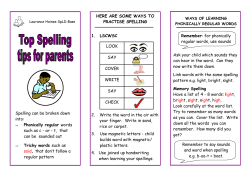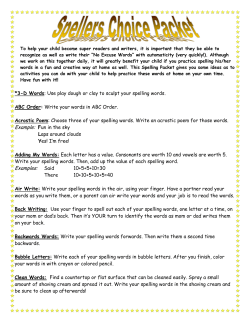
“Runifying” the BM website
“Runifying” the BM website Translating between alphabets involves a certain amount of compromise, especially when one of those alphabets is a form of the Scandinavian “Younger Futhark”, which contains only 16 letters. Here is a short explanation of how we went about it (although this is by no means the only way it could be done). The earliest runic inscriptions use an alphabet of 24 letters known to modern scholars as the “Older Futhark” (“futhark” comes from the sounds of the first six runes f u þ a r k). From around AD 700, carvers reduced the number of characters and favoured simpler forms, for unknown reasons. Some specialists think this was a deliberate, organised reform of the writing system while others disagree. Simplification seems to have been a trend that went further in some areas than others: the runes we have used here are the so-called “longbranch” forms, but many Viking-Age inscriptions use even simpler “short-twig” runes. For example, the runes h and s have the long-branch forms h and c, and the short-twig equivalents are e and s. Although the long-branch and short-twig runes are often presented as separate alphabets, in practice it was common for carvers to use a mixture of both types. For our present purposes we have used some common long-branch forms. The change from 24 to 16 characters meant that some runes had to be used for more than one sound: the b-rune b stood for both /b/ and /p/, the t-rune for /t/ and /d/, and the k-rune for /g/ and /k/. Perhaps more confusingly, the i-rune i was used for the sounds /i/ and /e/,. Simplifying the writing system in this way may make writing easier, but it makes reading more difficult because a sequence like biki, for instance, could be read in 16 different ways (biki, beki, beke, bike, piki, peki, peke, pike, bigi, begi, bege, bige, pigi, pege, pige, pegi). Some of the spelling rules used in runic inscriptions make things even more complicated: carvers usually avoided using double letters, and a “nasal” (n or m) could be left out before certain other consonants: the English word damp could be written Tæmb tamb or Tæb tab; and our imaginary sequence biki could stand for bikki, bekki, binki, benki etc. When dealing with real inscriptions, most of the possibilities are linguistically impossible, but reading can still be very difficult. These problems were not lost on the people who read and wrote with runes, and they started to devise solutions. Starting in the second half of the tenth century, we start to see dots added to runes as diacritics. These dots are not always used consistently, and not always in the same ways, but towards the end of the Viking period and in the later Middle Ages, we find runes such as dotted k g used for /g/, dotted b p for /p/, dotted t d for /d/ and dotted i e for /e/. Trying to adapt the 16-rune system for “runifying” the Roman alphabet as used in English means making some compromises. Some letters <a, b, f, h, i, k, l, m, n, o, r, s, t, u> have straightforward equivalents, even though the relationship between letter and sound is not always simple – especially for the vowels. We can use the third rune þ for the th-sounds in words like thin and this,1 but otherwise we have adhered to normal English spellings where 1 The letter þ is usually known by its Old English name þorn “thorn” (the Norse name is þyrs “giant, demon”), and it is a form of the þ-rune adapted for writing Old English from the Anglo-Saxon runic alphabet. This spelling practice was later adopted by Scandinavian scribes writing Old Norse, and the letter is still used in modern Icelandic spelling. 1 possible. We have followed the Viking-Age practices of “doubling up”, so that b also stands for <p>, and so on. The letter <c> is treated as equivalent to <k>, even where it is pronounced “soft” as in ice. The “runification” is a transliteration, not a phonetic transcription; that is to say, we are matching up letters of the two alphabets rather than trying to make the spelling match the sound (which would mean straying a long way from standard English spelling). In the early part of the Viking period, the rune o stood for a “nasalised” vowel sound /ã/, a bit like the vowel in French sans, while u was used for /o/. Later on, however, this nasalised vowel developed into an /o/-sound, and this is why we have used o as the equivalent of <o>. Several letters are a little trickier. We can treat <w> as equivalent to <u> and <y> (in its English use) as equivalent to <i> (so grey, for example, becomes krii krii). For <q> and <x> we have to use two runes (so <q> is ku, and <x> is ks). There are no runes which stand for the English sounds of <j> and <z>; for the former we have used i (since the letter <j> was simply a variant of <i> in Classical and Medieval spelling) and for the latter s (the nearest equivalent). This leaves <v>. Old Norse did not have /v/ as a distinct sound (a phoneme, to use linguistic jargon), but the runes b and f sometimes stood for a v-like sound (written [β] in phonetic notation) like the b of Spanish sabor. In “runifying” the website we have used f for <v>. Here are the runic equivalents for the letters of the Roman alphabet: Roman letter A B C D E F G H I J K L M N O P Q R S T TH U V W X Runic equivalent (and usual transliteration) æ a b b k k T t i i f f k k h h i i i i k k l l m m N n o o b b ku ku r r c s T t q þ u u f f u u kc ks 2 Y Z i c i s 3
© Copyright 2025





















